Wecall the short life-cycle crops those products that have a life span of maximum two years.
The ones wemare presenting are the results of the ‘natural selection’ of the ’innumerous’ other trialsthat occurred over the 12 years of our agricultural activity. These products ‘work’ in our microclimate, are or can be economically exploited in our kind of soil, have attractive local markets, areas that can be easily expanded if it needs to reach economic volumes, but can be started in small lots, with little investment and maintenance costs.
Last, but not least, there is enough in-house knowledge and experience to husband these kind of crops. Such knowledge is not trivial: there are many other interesting crops that could be considered, but new cultures must be studied, require experimentation, observation for at least a year or two, etc., before reaching a reasonably solid degree of their real potential of production and market viability.
For example, we already know what not to grow (with a minimal business objective) in this region: banana, pineapple, tapioca, cloves, are no, no, cultures. Just to name a few that we have experimented with and conclude on their economic un-attractiveness. Such conclusionsdid not come for economic reasons only: we looked at the climate, production, water needs, pests, processes, after harvest processing, market access, etc., just to start with. Those enclosed in this list passed all these tests. And soon we shall revisit them to select those crops that we shall add to the limes and coffee…
The produces that we shall consider in the future are:

The produces with a medium life cycle, are:

One could criticize (correctly) that our definition of short cycle crops is ‘unique’ to us. They would be right. Such selection is not only based on rational elements, but also on psychological, social and historical factors of the place. Maybe we should not separate such crops in to two groups… maybe the two cycles should be together and receive a more critical analysis … but it works for us and so … it is! (but can change.)
The pawpaw
We considered growing papaya in husbandry with the limes.
Pawpaw matures in eight to ten months and produces for two, max three years. Our manager, Wilson, had previous experience in growing this crop as a way ofbringing economic incomes rapidly, a sort of buffer while the limes trees mature to production: as a lime tree starts economic production in four years, papaya would supply needed funds for at least two of those years.
And so in 2010 we made our seedling from selected seeds and planted approximately 53 hectares.
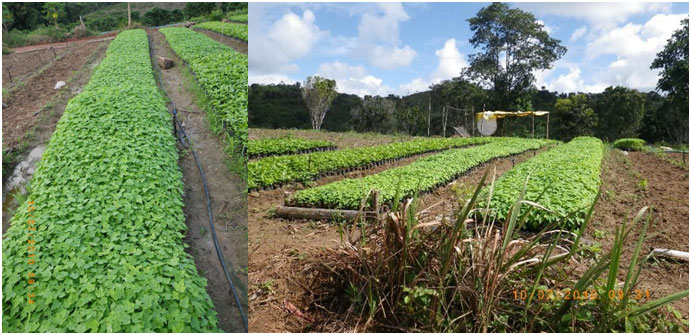
Then we planted, and planted, and planted… for two solid months!
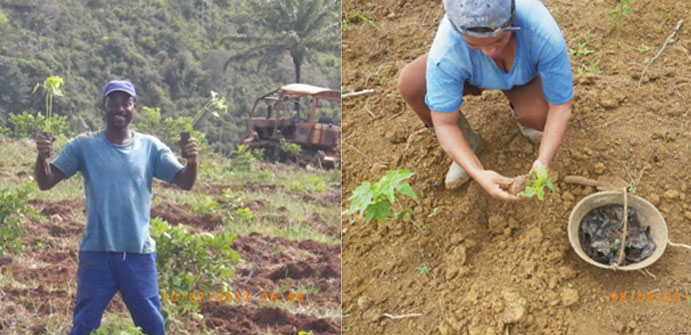
By September that year, we had 55 hectares of limes and papaya in the ground.

Toward the end of that year, we even made an emergency irrigation scheme, mainly to protect the pawpaw, as it is sensitive to the quantities of water offered. It was also a bonus for the limes, which need not such quantities, but grew faster than normal. And the pest control benefited both crops, and that was major economic factor: one shot for two birds sort of thing.
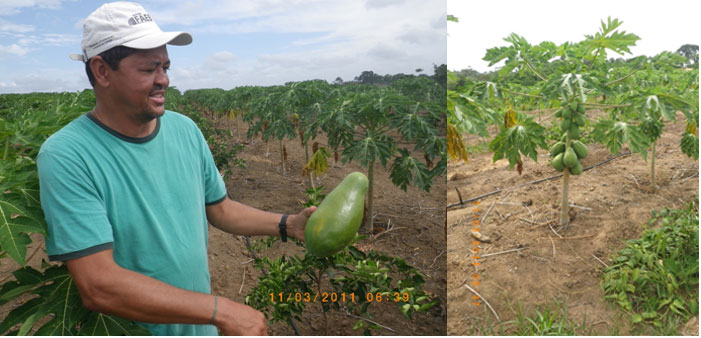
It was an excellent experience. In addition of helping our cash flow, we were amazed at the quality and flavor that these marvelous plants offered us. Not least Dona Lene, our comfort care-taker, who invented new ways of preparing papaws: from ice cream, sorbets, jams, meat curing, salads component, to papaya cream, a blended composition of ice cream and pawpaw with a touch of maraschino liquor!!!! Superb!!!

And as the papaya plants died in the second and third year, we left them in the field to decompose. In theory, we could have replanted until the fourth year, but the needs for sprayingsoon diverged for each crop, and the limes took priority: what for two years was good for both, in the third year became counterproductive. As the lime trees started to produce in the second and third year, in the fourth we could either spray papaya or harvest limes.
With the GlobalGAp certification and the severity of the inspections for MRL (Maximum Residues Levels) In Holland, we could not hesitate,
Also, pawpaw demands much more attention than limes, and maintaining such processes would distract us from our main goal of expanding the limes plantation and become independent. This same concern surfaced the following year when we planted maracujá, passion fruit, in husbandry with the limes.
The passion fruit, the maracujá

In 2011, with the accumulated experience of the papaw plantation, we decided to plant passion fruit in husbandry with limes, in the new areas of Peralba Rio and Peralba Nova Rio.
It was a success!!
Spraying and fertilizers matched perfectly and the plants received it with happiness: their growth was considered exceptional by our Wilson.
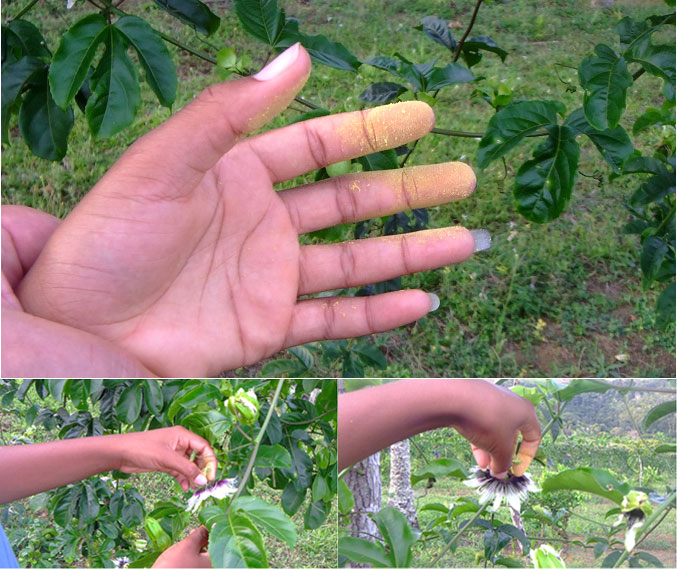
The exceptional growth of the lime trees was also due to the shadow that the passion fruit gave to the limes.

Husbandry of the maracujá crop was given to local farmers, almost all women, who literally enjoyed the pruning and …
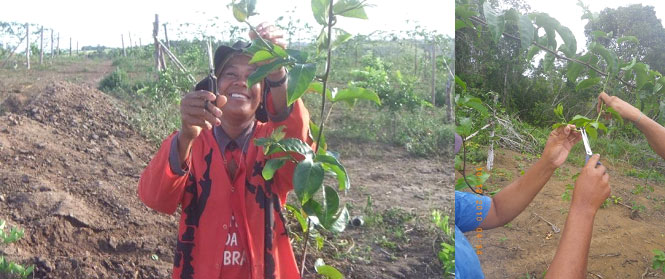
… the human insemination techniques, all carried on while singing and laughing!!…
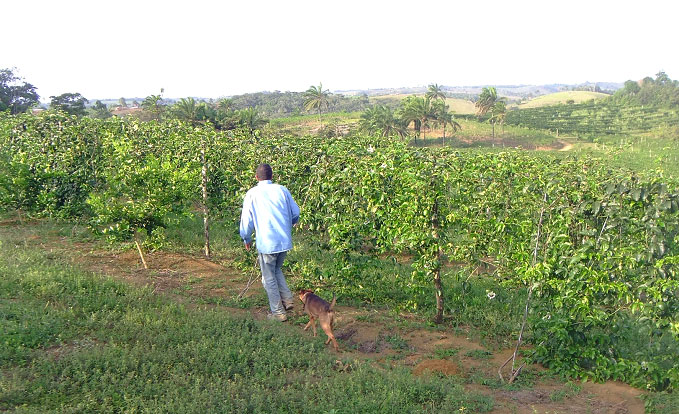
All in all, the passion fruit became an attractive product, easy to sell to wholesalers, but also to three supermarkets in Nazaré and Valença and Santo Antônio. In this way we kept costs down to a minimum.
Based on such success, in 2011 our Dutch partners became interested in planting this fruit to export to Europe. That meant allocating no less than 100 hectares to it… But… they demanded another kind, a reddish type, smaller than our, produced in and exported from South Africa, which had a very high acceptance in the European markets. Doubts abounded. So we decided to plant an experimental patch of five hectares.
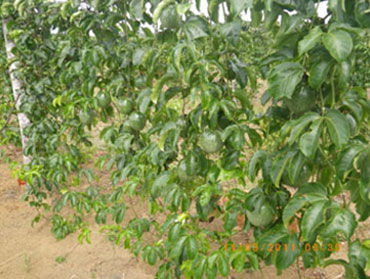
The Dutch demand came for specially selected seeds, had to pass phyto-sanitary inspection by the Brazilian authority and when that hurdle was past, all seemed ready… but for a detail: the look of the fruit! If that shape, color and sizes were accepted in the European market, nobody would buy them here.
The equation was simple: with some 30% to 40% were of a quality historically acceptable for export (as in South Africa), we had no way to sell the remaining fruit in the local markets: nobody would be interested in buying. Also, the cost of convincing the public to accept these fruits, would have demanded a far greater effort than we were able or willing to make. In all honesty, the fruit considered acceptable for export looked… funny… when compared with our local quality!! (and we even thought of offering our kind for export, but abandoned such an idea almost immediately based on the knowledge of several failed trials made in the past by serious growers: our fruit does travel, is exceedingly sensitive to temperature and degrades rapidly).
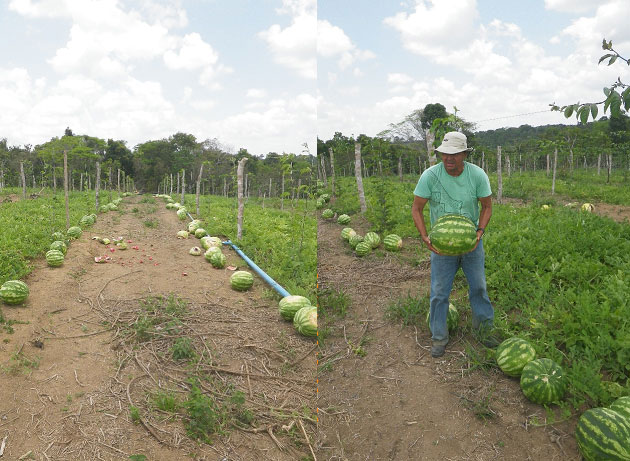
Even while we were closing sales with supermarkets, we were swamped by intermediary buyers: we had all sorts of offers, from one-price-buy-all-production to one-price-per-single-watermelon to one-truck-full-price, paid in cash on the spot, or by weight, paid in second hand cars, in motorcycles, in promissory notes for the next five years. We even had a proposition that the buyer would pay on the promise of paying within a month, on his word that he never cheated anybody in his whole life. It was a funny gold rush! We went our fumbling ways, trying several methods to get rid of the left over fruit as we approached the end of the harvesting period.

And the more we ate watermelons, the more were coming!

In 2010, as this crop was growing, our Dutch partners, during their routine visit to the limes, marveled at the abundance and vitality of our experiment with watermelons, so much so, that they immediately contacted a major seed producer. The rep flew the following day from São Paulo to visit and one month later we received sample seeds from South Africa of the kind of melons that travel well and are commonly sold in Europe. We immediately planned to put in the ground seeds for five hectares and started to dream of 50 or even 100 hectares of this crop in the following years.
Unfortunately, we did not consider at that time the realities of the local market.
We evaluated (almost) all aspects and all seemed favorable: soil, water quality, access, facilities, infrastructure, personnel, the lot. On the basis of the soil analysis, we dimensioned the needs for fertilizers. If it was good for the watermelons, things should go even better for the melons, as they were touted as more resistant to pests and to dry weather. And it did. We planted all four kind.
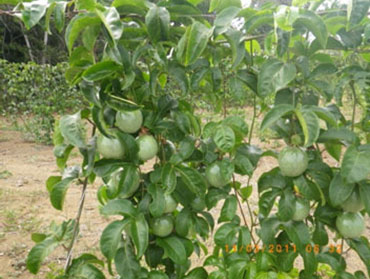
Wetried! We even looked at markets as in São Paulo, where people traveled overseas and would be more receptive to this new kind. In the supermarket where we placed fruit to experiment, none were sold. Disastrous. The economic equation would not close: in partnership with limes it made sense and brought a profit, alone… no way.
And so we had to abandon our experiment and our dreams of a special new crop.
We ate lots of funny looking passion fruit in 2012 and 2013!!!
But, for us, selling on the local market, the maracujá plantation in consortium with limes, was a success!
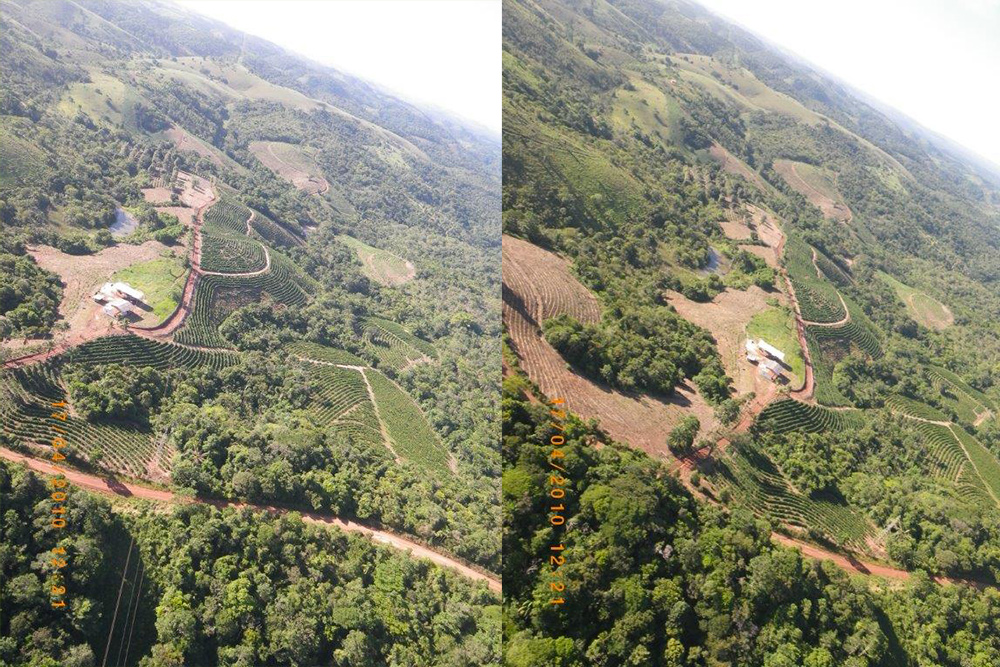
The net results of all this effort were huge watermelons, delicious, blood red inside, huge.
80 tons per hectare! We went directly to the supermarkets and sold it all. Had we double, we would have sold three times… nice.
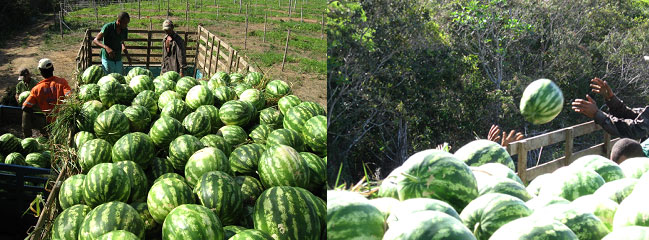
And we had our crop of surprises: bank check without funds, truck loads that disappeared (mostly paid in advance), weights that shrank at the weighting station, complaints that a load arrived all broken and that not a watermelons could be sold (and could we please replace such loads…) and so on.. but having to distribute 80 tons of fruit per hectare of a fast deteriorating product focused our attention and forced us to be creative in sorting out propositions: the fruit had to be sold.
All in all, it was fun! Profits paid nearly six months of salaries, but it certainly made us aware of the dynamics of this culture.
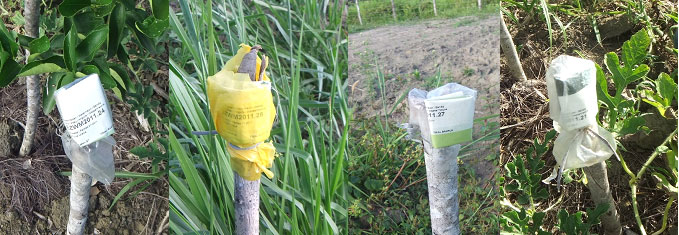
Again, the results were outstanding: excellent fruit, right color, right weight, right skin, right brightness, right taste, right everything.
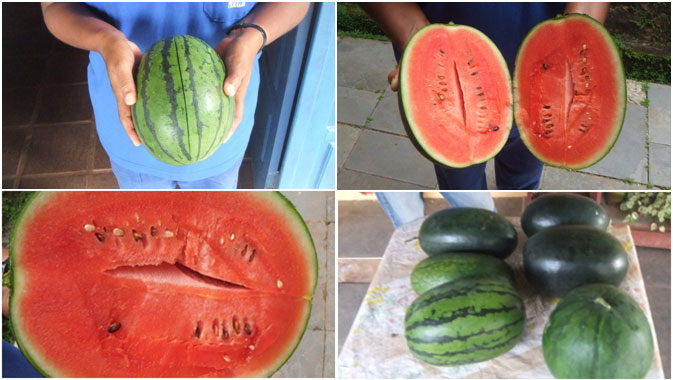
We started to get ready for the next step of 50 hectares… was it not for a small detail… two actually, but the first could have been solved somewhat easily:short production enveloped and no local market.
One characteristic of our climate is a rainfall between 1.600 e 2.400 mm, fairly well distributed during the year. Ideal for lime and also for melons, but, in the winter months from April to August, there are lots of clouds and light is strongly reduced. During those months, growth slows and this reduces the maturation period of melons. We call this a restricted envelop. This situation can be expanded substantially by choosing the right months for planting and inducing a fast growth with emergency irrigation. A can do situation.
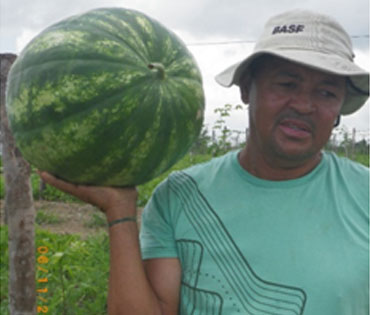
Water melons and melons 2010 and 2011 were experimental years. The limes elevated to principal crop, pawpaw and maracujá, passion fruit, in husbandry with the limes, coffee growing happily in a secluded part of the farm… and now came the idea of a trial patch of watermelons in between the lines of passion fruit and limes, to expand eventually into separate plantations as the results allowed it.
We actually had two opportunities with this crop: the watermelons for the local market and the specialty melons for export.
Again our field marshal, o Dr. Wilson, was heading the conception and execution of this new program. We needed all his experience and leadership, as the watermelons, and later the melons, were planted in between the limes and the maracujá! And for eight months all three crops lived together in an area of some 20 hectares, dodging spraying and fertilization processes, till we harvested watermelons and maracujá in synchronism. The positive results we got were exclusively due to the husbandry of our heroic Mr. Wilson!

And in this period we had watermelons for breakfast, lunch and dinner!

We went through all this theater for two years. In 2012, the limes and maracujá madeit impossible to take care of the watermelons in between them.
We planned to plant more in 2013, when the 2012 draught hit. Lucky us, as this product disappeared from the tables of Salvador that year.
Alba loved the whole process!!
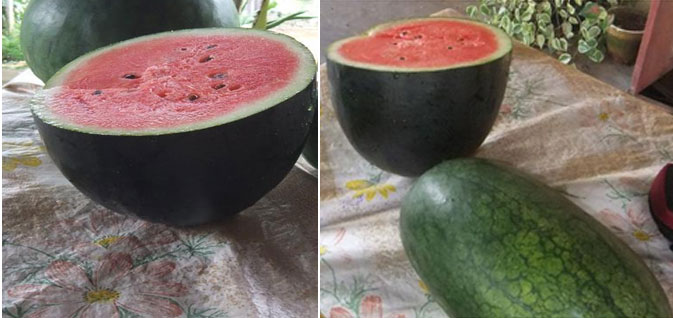
What killed the project was the inexistence of a market for such new produces: all the supermarkets our clients tried to sell our melons to did not want to buy them. It was unknown,and lookedupon with suspicion, as they were smaller than the traditional watermelons. The cost to introduce a new product and be accepted by a reasonable number of buyers put off all distributors and supermarkets. We found out that Brazilians in Salvador are not famous for experimenting with new fruit.
As between 50% and even 70% of this fruit would not be of export quality, it became quickly evident that, with prices practiced in the EU and the inability of distributing the excess production in the local market, the economics of the venture would be
substantially negative.
Same response as the maracujá.
Sad, because it all had to be a success.

Then, in 2016, at the time of this writing, things started to change: today we can find these melons in several upscale supermarkets in Salvador and in some specialty shops. That means that someone did have the wherewithal to produce and stick to the product.
In São Paulo, apparently the acceptance of this kind of melons increased substantially in the last years and their offer is more diffused.
Who know that sometimes, soon, in the future, we shall not revisit such a project?!
Ornamental flowers
 We planted ornamental flower for only one season, but its results were so enticing that we are relating them with an eye to a possible future for this produce.
We planted ornamental flower for only one season, but its results were so enticing that we are relating them with an eye to a possible future for this produce.
In 2013, Dr. Vernon Aaron, a researcher in biology at the University of Irvine, in California, visited us with our good friends and sponsor of the planting of the music trees project, Dr. James Gardner and Dr. Anne Breuer-Gardner. As good biologists do, he went in the most recondite places of the forest, the ones that are so thick and dense that at 2pm it seems is night on the ground, so thick is the trees canopy there. And he came back all exited, that he found an unknown flower, the same as his photo, here below.
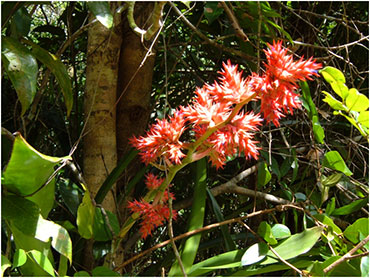
When we told him that often we find such flowers growing in the fields and that we sort of consider it a nuisance, he became even more interested and asked if we were interested in growing this flower on a commercial basis. We responded with doubts and concerns, that to do so we would need men trained, economic quantities, packaging, sales overseas… etc, the usual óh boy what is this guy asking us to do’ syndrome. He did not give up. He asked for the permission to plant in a small lot near where he found the flowers. He was serious!
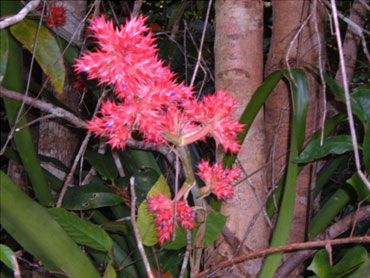
Detailed negotiation ensued: he would be the only responsible one for it, pay and train the worked dedicated to it, harvest, pack, sale, ship, the whole thing, in his hands. He accepted. We cleaned one hectare for him. The he went to work.
And so he planted.
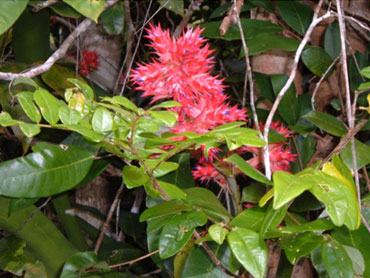
Every month he endured the 20+-hour plane trip to visit the patch. Six month afterwards, strange looking cartons arrived with Dr. Aaron en-suite. He packed, loaded and shipped some 2348 cartons back to the States. He cleaned the patch, replanted the small growth that was cleared, left as if nothing had happened there. He told us he had made a small fortune with it. We received as thanks, a wooden box with 24 bottle of old whiskey.
I passed by recently and I could see no trace of the exploit. Maybe a couple of flowers that grew in spite of his cleaning up.
It gave us a sense that we missed something. That maybe, maybe, we should have looked at this forest produce with more care, that there is a lovely business in it… we’ll see.

.jpg)
.jpg)
.jpg)
.jpg)
.jpg)
.jpg)
.jpg)
.jpg)
.jpg)
.jpg)
.jpg)
.jpg)
.jpg)
.jpg)
.jpg)
.jpg)
.jpg)
.jpg)
.jpg)
.jpg)